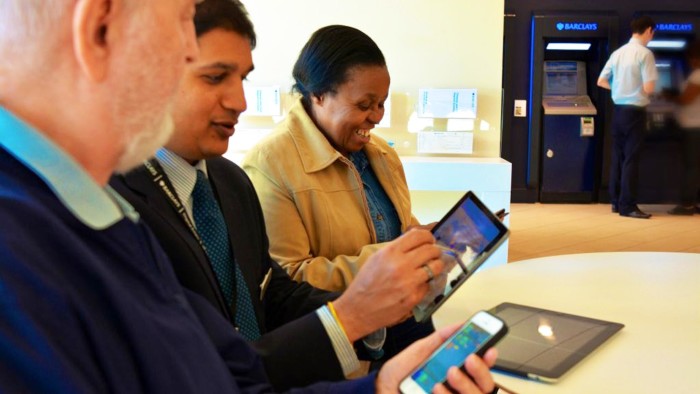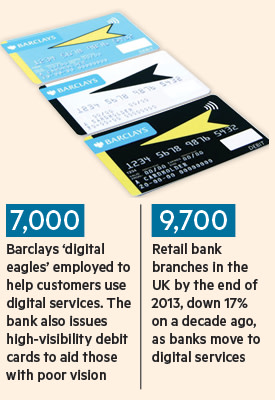The Silver Economy: Banks adjust digital vision for the tech-no’s

Roula Khalaf, Editor of the FT, selects her favourite stories in this weekly newsletter.
On a busy morning at a central London branch of Barclays there is a sense of unease among many of the queueing customers.
The usual features of a bank – the glass counter and boxlike meeting rooms – have disappeared. Instead there is a row of flashing machines and some cheery looking staff walking around clutching iPads.
The only serviced desk is for small business customers. But regular customers in their sixties and seventies are waiting anyway, preferring to speak to someone rather than approach a machine.
It presents a paradox for lenders around the world, as they invest heavily in technology to cut costs and simplify services, but seek to retain one of their fastest-growing customer groups.
“People aged 15-30 are natural digital adopters,” says Steven Roberts at Barclays. “But older people, who account for a lot of the country’s wealth and wealth generation, often feel uncomfortable with technology.”
Barclays has tried to address the issue by employing 7,000 so-called “digital eagles” – technophile staff who help customers with digital services, from accessing bank accounts on mobiles, to calling grandchildren via Skype.
Its staff and product developers have also been encouraged to try an age-simulation suit that mimics conditions such as impaired vision, deafness and joint stiffness that may come with old age.
As a result Barclays has launched a number of new products including high-visibility debit cards, which feature bright arrows signalling the way cards should be inserted in machines and high-contrast colours to make it easier for customers to read the card details. The bank has also introduced “paytag” stickers that can be attached to mobile phones or key rings and operate in the same way as contactless credit cards.
Other banks are also attempting to adapt their basic services for older customers. Lenders including Bank of America in the US, Australia’s Westpac and the UK’s Co-operative Bank and Barclays have installed talking ATMs.

The drive to help ageing customers acclimatise to new technology is being adopted by banks around the world. There is evidence that, once comfortable with technology, older account holders become enthusiastic adopters. A report by PwC found that of those who banked digitally, baby boomers used online services even more than younger generations.
However, consumer groups have raised concerns that the rise in digital banking will inevitably lead to an even greater fall in the shrinking number of branches, which remain the preferred channel for many older customers.
“Older people really value face-to-face services and could well struggle to use alternatives,” says Lucy Malenczuk, a senior policy manager at Age UK. “The fact is that banks feel under pressure to save money.” She adds that some elderly customers have found it hard to access their money as they struggle to use ATM machines and banks are increasingly removing counter services.
Lenders in the UK, US and Europe have been criticised for shutting branches as a result of falling demand from customers who increasingly prefer to bank online.
So far this year British banks have closed about 300 branches, according to the Campaign for Community Banking Services pressure group – more than for the whole of 2013. At the end of December 2013 there were about 9,700 retail branches in the UK, a 17 per cent reduction from a decade ago.
FT series

How industries ranging from technology to entertainment are waking up to the opportunities provided by the world’s rapidly ageing population
Further reading
In the US bank branch closures hit a record level last year of 1,487, according to SNL Financial, the research firm.
The challenge for banks is to shift their older wealthier customers to digital platforms fast enough that branch closures matter less.
RBS in the UK offers a mobile banking service – a new fleet of high-tech vans kitted out with iPads and internet access – that drive around small towns and villages in rural areas giving local residents the chance to do their banking.
The service was introduced in 1946 on the Isle of Lewis in Scotland to help residents who were too busy weaving tweed to make it to the bank in the nearest large town. But RBS has discovered that these mobile services are now particularly helpful to the very customers it most wants to keep.
The Gert suit: ‘I was exhausted after just a few minutes’
Walking just a few steps is tiring; everyday tasks, such as withdrawing cash from an ATM or speaking to a branch manager about opening an account are difficult. And you feel vulnerable and weak. Welcome to old age.
Barclays is asking its staff to feel first-hand the effects of ageing by donning a suit designed to mimic the impediments suffered by a growing number of the bank’s clients.
Trying out the Gert suit – short for Gerontologic test – in a busy central London branch of Barclays, the challenges facing older customers in navigating even the simplest everyday tasks were laid bare.
Heavy weights around the chest, ankles and wrists inhibited my mobility and imitated joint stiffness. Headphones blocked out high frequency sound and thick yellow-tinted goggles severely impaired my vision. My overriding sensation was frustration that my body would not respond the way I wanted it to. And I was exhausted after just a few minutes.
Barclays says it has used the experiences of staff and product developers who have tested the suit to devise new products and services for older customers who come to their diminishing number of branches.
But with banks wanting more of customers to bank online and, particularly, on smartphones and tablets, the next challenge for Barclays – and many others – will be to find new ways to help older clients use these devices too.

Comments